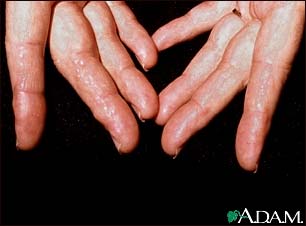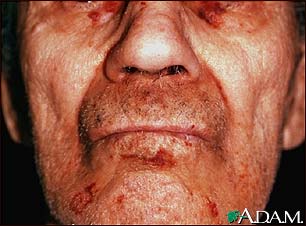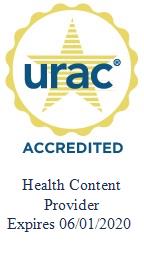Health Library
Primary amyloidosis
Amyloidosis - primary; Immunoglobulin light chain amyloidosis; Primary systemic amyloidosis
Primary amyloidosis is a rare disorder in which abnormal proteins build up in tissues and organs. Clumps of the abnormal proteins are called amyloid deposits.
Images


I Would Like to Learn About:
Causes
The cause of primary amyloidosis is not well understood. Genes may play a role.
The condition is related to abnormal and excess production of proteins. Clumps of abnormal proteins build up in certain organs. This makes it harder for the organs to work correctly.
Primary amyloidosis can lead to conditions that include:
- Carpal tunnel syndrome (due to nerve deposits)
- Heart muscle damage (cardiomyopathy) leading to congestive heart failure
- Intestinal malabsorption
- Liver swelling and malfunction
- Kidney failure
- Nephrotic syndrome (group of symptoms that includes protein in the urine, low blood protein levels in the blood, high cholesterol levels, high triglyceride levels, and swelling throughout the body)
- Nerve problems (neuropathy)
- Orthostatic hypotension (drop in blood pressure when you stand up)
Symptoms
Symptoms depend on the organs affected. This disease can affect many organs and tissues, including the tongue, intestines, skeletal and smooth muscles, nerves, skin, ligaments, heart, liver, spleen, and kidneys.
Symptoms may include any of the following:
- Abnormal heart rhythm
- Fatigue
- Numbness of hands or feet
- Shortness of breath
- Skin changes
- Swallowing problems
- Swelling in the arms and legs
- Swollen tongue
- Weak hand grip
- Weight loss or weight gain
Other symptoms that may occur with this disease:
- Decreased urine output
- Diarrhea
- Hoarseness or changing voice
- Joint pain
- Weakness
Exams and Tests
The health care provider will examine you. You will be asked about your medical history and symptoms. A physical exam may show that you have a swollen liver or spleen, or signs of heart or nerve damage.
The first step in diagnosing amyloidosis should be blood and urine tests to look for abnormal proteins.
Other tests depend on your symptoms and the organ that may be affected. Some tests include:
- Abdominal ultrasound to check the liver and spleen
- Heart tests, such as an ECG, echocardiogram, or MRI
- Kidney function tests to check for signs of kidney damage (nephrotic syndrome or renal insufficiency)
Tests that can help confirm the diagnosis include:
- Abdominal fat pad aspiration
- Bone marrow biopsy
- Heart muscle biopsy
- Rectal mucosa biopsy
Treatment
Treatment may include:
- Chemotherapy
- Stem cell transplant
- Organ transplant
If the condition is caused by another disease, that disease should be aggressively treated. This may improve symptoms or slow the disease from getting worse. Complications such as heart failure, kidney failure, and other problems can sometimes be treated, when needed.
Outlook (Prognosis)
How well you do depends on which organs are affected. Heart and kidney involvement may lead to organ failure and death. Body-wide (systemic) amyloidosis can lead to death within 2 years.
When to Contact a Medical Professional
Call your provider if you have symptoms of this disease. Also call if you have been diagnosed with this disease and have:
- Decreased urination
- Difficulty breathing
- Swelling of the ankles or other body parts that does not go away
Prevention
There is no known prevention for primary amyloidosis.
Related Information
CardiomyopathyAcute kidney failure
Carpal tunnel syndrome
Malabsorption
Endocrine glands
Respiratory
References
Gertz MA. Amyloidosis. In: Goldman L, Schafer AI, eds. Goldman-Cecil Medicine. 26th ed. Philadelphia, PA: Elsevier; 2020:chap 179.
Gertz MA, Buadi FK, Lacy MQ, Hayman SR. Immunoglobulin light-chain amyloidosis (primary amyloidosis). In: Hoffman R, Benz EJ, Silberstein LE, et al, eds. Hematology: Basic Principles and Practice. 7th ed. Philadelphia, PA: Elsevier; 2018:chap 88.
Hawkins PN. Amyloidosis. In: Hochberg MC, Gravallese EM, Silman AJ, Smolen JS, Weinblatt ME, Weisman MH, eds. Rheumatology. 7th ed. Philadelphia, PA: Elsevier; 2019:chap 177.
BACK TO TOPReview Date: 1/17/2021
Reviewed By: David C. Dugdale, III, MD, Professor of Medicine, Division of General Medicine, Department of Medicine, University of Washington School of Medicine. Also reviewed by David Zieve, MD, MHA, Medical Director, Brenda Conaway, Editorial Director, and the A.D.A.M. Editorial team.
 | A.D.A.M., Inc. is accredited by URAC, for Health Content Provider (www.urac.org). URAC's accreditation program is an independent audit to verify that A.D.A.M. follows rigorous standards of quality and accountability. A.D.A.M. is among the first to achieve this important distinction for online health information and services. Learn more about A.D.A.M.'s editorial policy, editorial process and privacy policy. A.D.A.M. is also a founding member of Hi-Ethics. This site complies with the HONcode standard for trustworthy health information: verify here. |
The information provided herein should not be used during any medical emergency or for the diagnosis or treatment of any medical condition. A licensed medical professional should be consulted for diagnosis and treatment of any and all medical conditions. Links to other sites are provided for information only -- they do not constitute endorsements of those other sites. © 1997- 2021 A.D.A.M., a business unit of Ebix, Inc. Any duplication or distribution of the information contained herein is strictly prohibited.
